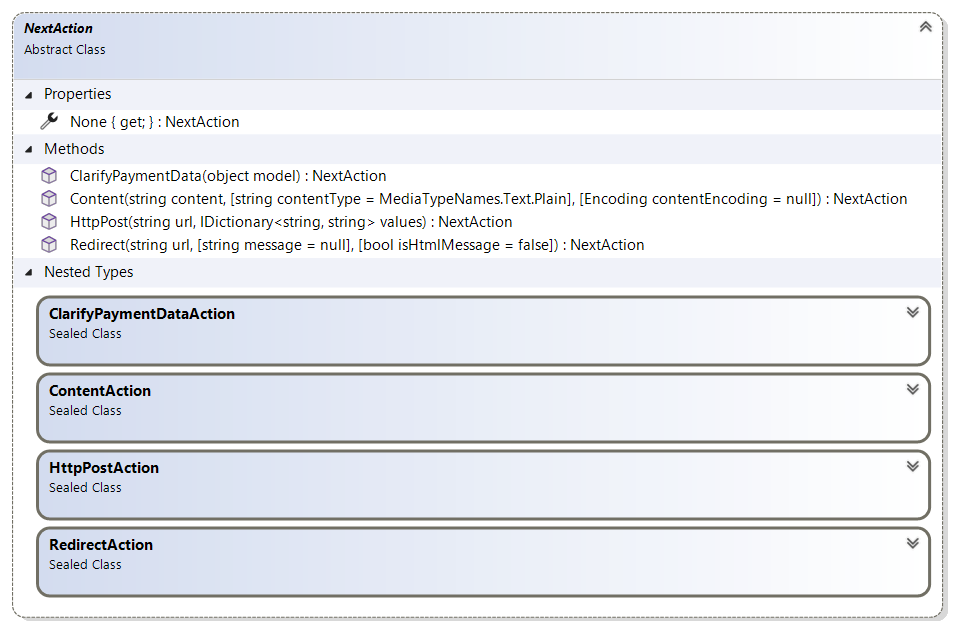NextAction reference
Determines the next action that needs to be executed by Sana Commerce Cloud after payment extension completes
certain step. For example an instance of this type should be returned by payment extension's
StartPayment or ProcessCallback methods to indicate what Sana Commerce Cloud needs to do after these
methods are complete.

NextAction.None
Tells Sana Commerce Cloud that no particular action needs to be executed. Returns null.
For example, let's assume we have a payment extension and its ProcessCallback method implemented.
Let's say our payment service provider will at some point do a callback to Sana Commerce Cloud and expects only an
HTTP 200 status response from it. In such case we need to implement ProcessCallback method in such
way that it returns NextAction.None to indicate to Sana Commerce Cloud that nothing else needs to be done and that
the request can be finished:
public override NextAction ProcessCallback(PaymentContext context)
{
// We assume that here we have some implemented logic of the callback processing.
...
// In the end by returning NextAction.None we tell Sana Commerce Cloud to do nothing
// so that the request just ends and HTTP 200 status is returned to the payment service.
return NextAction.None;
}
NextAction.HttpPost
Tells Sana Commerce Cloud to send an HTTP POST request to specified URL with specified form values.
Returns an instance of NextAction.HttpPostAction nested type.
It can be used in StartPayment method of the payment extension to post the data to the
payment service provider:
public override NextAction StartPayment(PaymentStartContext context)
{
// valuesToPost is the dictionary containing the values to post to the payment service provider.
var valuesToPost = new Dictionary<string, string>
{
{ "id", context.TransactionId }
};
...
// paymentUrl here is the URL of the payment service provider's page.
return NextAction.HttpPost(paymentUrl, valuesToPost);
}
NextAction.Redirect
Tells Sana Commerce Cloud to perform a redirect to specified URL. Returns an instance of NextAction.RedirectAction
nested type.
It can be used in StartPayment method of the payment extension to redirect the user to
the payment service provider's page:
public override NextAction StartPayment(PaymentStartContext context)
{
...
// paymentUrl here is the URL of the payment service provider's page.
return NextAction.Redirect(paymentUrl);
}
You can specify an optional message that will be shown to the user while the redirect is being performed in the user's browser:
return NextAction.Redirect(paymentUrl, "Please wait while we are redirecting you to the payment service provider page...");
The message can be also a piece of HTML markup if you need to beautify it with some formatting.
To do this pass true as isHtmlMessage parameter:
string formattedMessage = "<h1>Redirecting...<h1><div>Please wait while we are redirecting you to the payment service provider page...<div>";
return NextAction.Redirect(paymentUrl, formattedMessage, isHtmlMessage: true);
NextAction.Content
Tells Sana Commerce Cloud to respond to the request with custom content provided by the extension.
Returns an instance of NextAction.ContentResponseAction nested type.
It can be used in ProcessCallback method of the payment extension to respond to the callback using format required by the PSP.
Let's say our payment service provider will at some point do a callback to Sana Commerce Cloud and expect 'Success' response string in UTF-8 encoding with HTTP 200 status from it:
public override NextAction ProcessCallback(PaymentContext context)
{
// We assume that here we have some implemented logic of the callback processing
// (e.g. payment status is retrieved from `context.HttpContext` and passed to `context.State.PaymentStatus`).
...
// By returning NextAction.Content we tell Sana Commerce Cloud to write plain "Success" string in UTF8 encoding to the response body.
return NextAction.Content("Success", contentEncoding: Encoding.UTF8);
}
NextAction.ClarifyPaymentData
Tells Sana Commerce Cloud that the provided payment data is incomplete/incorrect and an user should take an action to make it right.
It should be used in StartPayment method of the payment extension to transfer an additional data to the extra checkout step client model:
public override NextAction StartPayment(PaymentStartContext context)
{
// We assume that here we have some implemented logic to validate payment information
...
return NextAction.ClarifyPaymentData(new {
refusalReason: "Card was declined"
});
}